Purdy and Henderson, Engineers
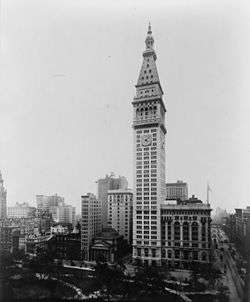 | |
| Purdy and Henderson | |
| Partnership | |
| Industry | Construction |
| Headquarters | New York, New York, 1894 |
Number of locations | Boston, Massachusetts; Chicago, Illinois; Seattle, Washington; and Havana, Cuba |
| Services | Enginnering |
Corydon Purdy and Lightner Henderson started an engineering office in Chicago, IL, by the name of Purdy and Henderson, Engineers in the early 1890s. Soon thereafter, transferred the headquarters of their practice to New York City by 1896. They developed branch offices in various locations, including Boston, Massachusetts; Chicago, Illinois; Seattle, Washington; and Havana, Cuba at 32 Calle Empedrado.[1] This aggressive firm was a Patron of the Seattle Architectural Club in 1910. Lightner Henderson died prematurely in 1916, but the firm continued to operate under this name well after his death. It, for example, collaborated with architect H. Craig Severance (1879-1941) on the Bank of Manhattan Trust Building (New York, NY, 1929-1930), which, for about one month (04-05/1930), was the tallest building in the world. The firm most likely closed at about the time of Corydon Purdy's death in 1944.[2] They worked on the Agen, John B., Warehouse, Downtown, Seattle, WA. in 1910 and the Royal Insurance Company, Limited, Headquarters Building #2, Financial District, San Francisco, CA, among others.[3][4] Purdy and Henderson designed several buildings in New York City including New York Times Building at Times Square, Macy's Building on thirty four street, and the Flatiron Building at twenty third street and fifth avenue, among others[5]
Corydon Tyler Purdy
Professional History
Draftsman and Surveyor’s Assistant, Chicago, Milwaukee and Saint Paul Railroad, Chicago, IL, c. 1880-1881; Assistant Engineer, Chicago and Evanston Railway, Chicago, IL, c. 1881-1883; City Engineer, City of Eau Claire, WI, 1886-1888; Engineer, Keystone Bridge Company, Pittsburgh, PA, 1888-1889; Partner, [Charles G.] Wade and Purdy, Engineers, Chicago, IL, 1889-1891; Partner, Purdy and [John T.] Phillips, Engineers, Chicago, IL, 1891-1893; Purdy specialized early in his career in bridge design. He also applied his skills to skyscrapers, working as the structural engineer for the innovative steel frame of the 13-story Tacoma Building, Chicago, IL, (Holabird and Roche, Architects), 1887-1889. Partner, Purdy and Henderson, Engineers, Chicago, IL, 1893-1944; Purdy and Henderson opened a New York, NY, office in 1894 and moved its base of operations to the city by about 1896. This New York office designed the structural scheme for the Waldorf-Astoria Hotel in New York, NY. (Schultze and Weaver, Architects, 1893-1897). In 1899, Purdy also supervised the start-up of a New York office for his friend, George A. Fuller (1851-1900), the Boston building contractor. (Purdy would maintain a close relationship with the prolific Fuller Company.) By 1900, Purdy and Henderson had obtained consulting work all over the US and in several foreign countries, most notably Cuba; by 1910, the firm had its New York headquarters and four other offices: Havana, Boston, MA, Chicago, IL, and Seattle, WA; it was through this Seattle office that Purdy and Henderson consulted on West Coast projects. In his lifetime, Purdy witnessed the rise of skyscraper structural systems from the 140-foot range to well over 1,000 feet, much of the reason for this increase being his advocacy, example, and influence. In 1930, during the depths of the Depression, his structural engineering company was involved in a fantastic and dramatic three-way race to build the world’s tallest building, an American structure even taller than the Eiffel Tower in France.[6] The Purdy and Henderson firm closed shortly after Purdy's death.
He was a member, American Society of Civil Engineers; Member, Institute of Civil Engineers of Great Britain; Member, Western Society of Engineers; Member, Engineers' Club of New York; Member, University of Wisconsin Alumni Club of New York; Member, Arctic Club, Seattle, WA;
He won the Telford Premium Medal, Institute of Civil Engineers, London, UK, 1909;
Education
Purdy attended primary and secondary schools in WI, c. 1877. A.B. University of Wisconsin, Madison, WI, 1885; B.S., Civil Engineering, University of Wisconsin, Madison, WI, 1886. ngineering, University of Wisconsin, Madison, WI, 1886.[6]
Writings
Purdy was a prolific writer and speaker. He spoke at national events for professional groups to which he belonged and for others like the Boston Society of Engineers. He frequently gave keynote and educational lectures at his alma mater (UW), Cornell University, and other institutions of engineering study. Said Purdy:[6]
“The days of wooden bridges and buildings, and heavy masonry are numbered. Iron and other metals are rapidly taking their place. Engineers of the future must know the names and uses of the different forms in which iron or steel is produced, and they should know when a channel can be used to better advantage than a beam, and when an angle bar will serve better than a plate. In other words, they should well understand the particular characteristic of every form and shape of iron or steel which makes that particular form, shape, or kind most valuable in any given place or for any given use.” (Bulletin of the University of Wisconsin, 1894)
Representative of Purdy’s published writings, most of them seminal papers in many areas, are the following:
- “The Steel Skeleton Type of High Building” (Engineering News, 1891)
- “The Steel Construction of Buildings” (Bulletin of the University of Wisconsin, 1894)
- “The Use of Steel in Large Buildings” (Engineering Record, 1895)
- “Can Buildings Be Made Fireproof?” (Transactions of the American Society of Civil Engineers, 1898)
- “The Relation of the Engineer to the Architect” (Proceedings of the American Institute of Architects, 1904)
- “The New York Times Building” (Proceedings of the Institution of Civil Engineers, 1909)
Lightner Henderson
Professional History
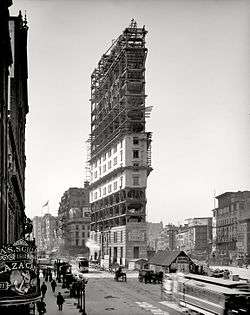
Engineer, Binder and Seifert, Engineers, Philadelphia, PA, c. 1889-1890; Henderson worked c. 1890 for an engineering concern in Cleveland, OH; Engineer, Purdy and [John T.] Phillips, Engineers, Chicago, IL, summer 1891-c. 1893; Partner, Purdy and Henderson, Civil Engineers and Consulting Engineers, Chicago, IL, c. 1893-1916; the firm moved its base of operations to New York, NY, in 1896. Purdy and Henderson formally incorporated in 1901. After incorporation, Henderson became the President of the concern from 1901-1915. Purdy and Henderson took on work outside of the Eastern US, and did projects on the West Coast in San Francisco, CA, and Seattle, WA. In about 1900, Purdy and Henderson had offices in New York, NY, Boston, MA, Chicago, IL, Havana, Cuba and Seattle, WA.
Member, Western Society of Engineers, 09/1891-1916.
Education
Henderson was educated in Lancaster County, PA, public schools. He attended the State Normal School in Millersville, PA, and obtained his B.S. in Civil Engineering from Lehigh University, Bethlehem, PA, in 1889.
An obituary prepared, in part, by his partner, Corydon Purdy, stated of him: "His achievements of these years, from 1893 through two decades were notable, and mark him as one of the great structural engineers of his day. He was of a very retiring disposition and rather shunned the association of other men. On this account, he was not as widely known, and the quite remarkable character of the man was not as widely recognized as it would have been otherwise....Along with his analytical powers of mind, there was always a practical turn to it, which never was submerged by the complication or the laborious character of a difficulty. He did not arrive at irrational or impracticable conclusions. Simplicity was the distinguishing mark of his designing. It was these two qualities of mind combined that made him so successful in his profession."[7]
References
- ↑ "Purdy & Henderson". Retrieved 2018-10-13.
- ↑ "Purdy and Henderson, Engineers (Partnership)". Retrieved 2018-10-12.
- ↑ "John B., Warehouse, Downtown, Seattle, WA". Retrieved 2018-10-12.
- ↑ "Royal Insurance Company, Limited". Retrieved 2018-10-12.
- ↑ "The Flatiron Building". Retrieved 2018-10-11.
- 1 2 3 Weingardt, Richard G. (2010). "Corydon Tyler Purdy". Leadership and Management in Engineering. 10 (3): 124–130. doi:10.1061/(ASCE)LM.1943-5630.0000067.
- ↑ "Lightner Henderson," Journal of the Western Society of Engineers, vol. 21, no. 9, 11/1916, p. 784-786.
Selected commissions
- 1902 The Flatiron Building New York City
- 1904 The Bellevue-Stratford Hotel Philadelphia, Pa.
- 1907 Macy's in Herald Square New York, NY
- 1911 The Metropolitan Life Tower, New York, NY
- 1919 Royal Bank of Canada Building, Havana. Cuba
- 1926 El Capitolio, Havana, Cuba
- 1930 Bank of Manhattan Trust Building, New York, NY
- 1931 Starrett-Lehigh Building, New York, NY
Gallery
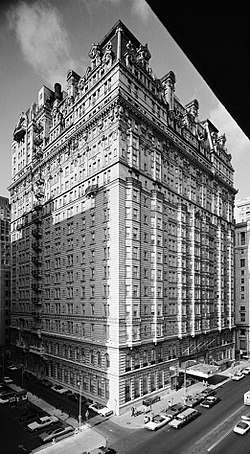 Bellevue-Stratford Hotel. Philadelphia, Pa. 1902
Bellevue-Stratford Hotel. Philadelphia, Pa. 1902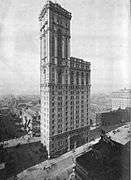 NY Times Buiilding. 1904
NY Times Buiilding. 1904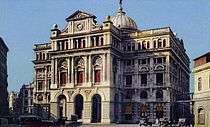 Lonja del Comercio building, Havana, Cuba. 1909
Lonja del Comercio building, Havana, Cuba. 1909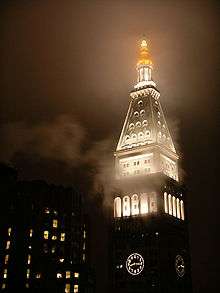 Metropolitan Life Insurance Company Tower. New York, NY. 1911
Metropolitan Life Insurance Company Tower. New York, NY. 1911.jpg) Centro Gallego. Havana, Cuba. 1915
Centro Gallego. Havana, Cuba. 1915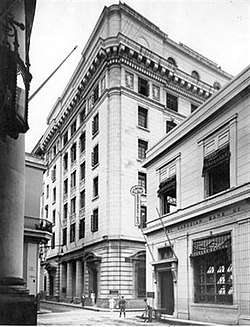 Royal Bank of Canada Building, Havana, Cuba. 1919
Royal Bank of Canada Building, Havana, Cuba. 1919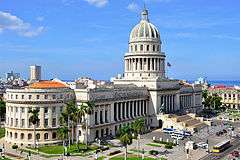 El Capitolio. Havana, Cuba. 1926
El Capitolio. Havana, Cuba. 1926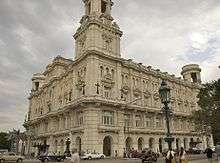 El Centro Asturiano, Havana, Cuba. 1927
El Centro Asturiano, Havana, Cuba. 1927 Manahattan Trust Tower. New York, NY. 1930
Manahattan Trust Tower. New York, NY. 1930.jpg) Starrett-Lehigh Building, NY City. 1931
Starrett-Lehigh Building, NY City. 1931 Radio Centro Complex, Havana, Cuba. 1947
Radio Centro Complex, Havana, Cuba. 1947